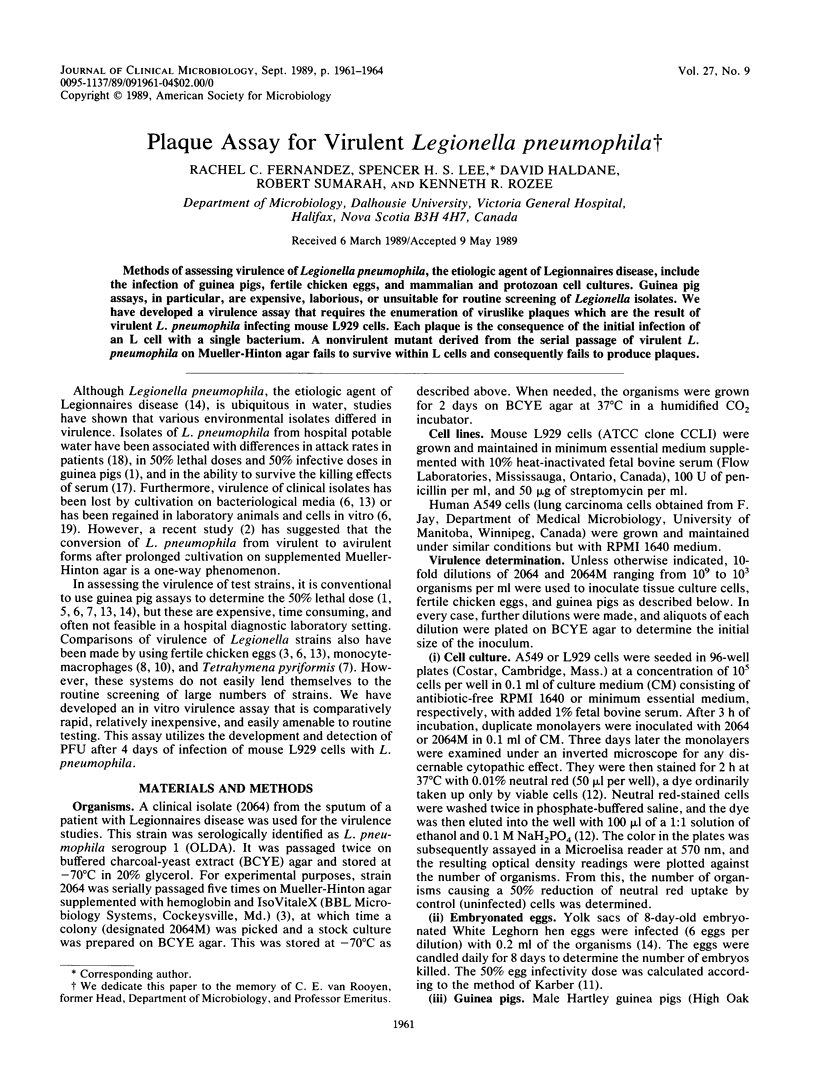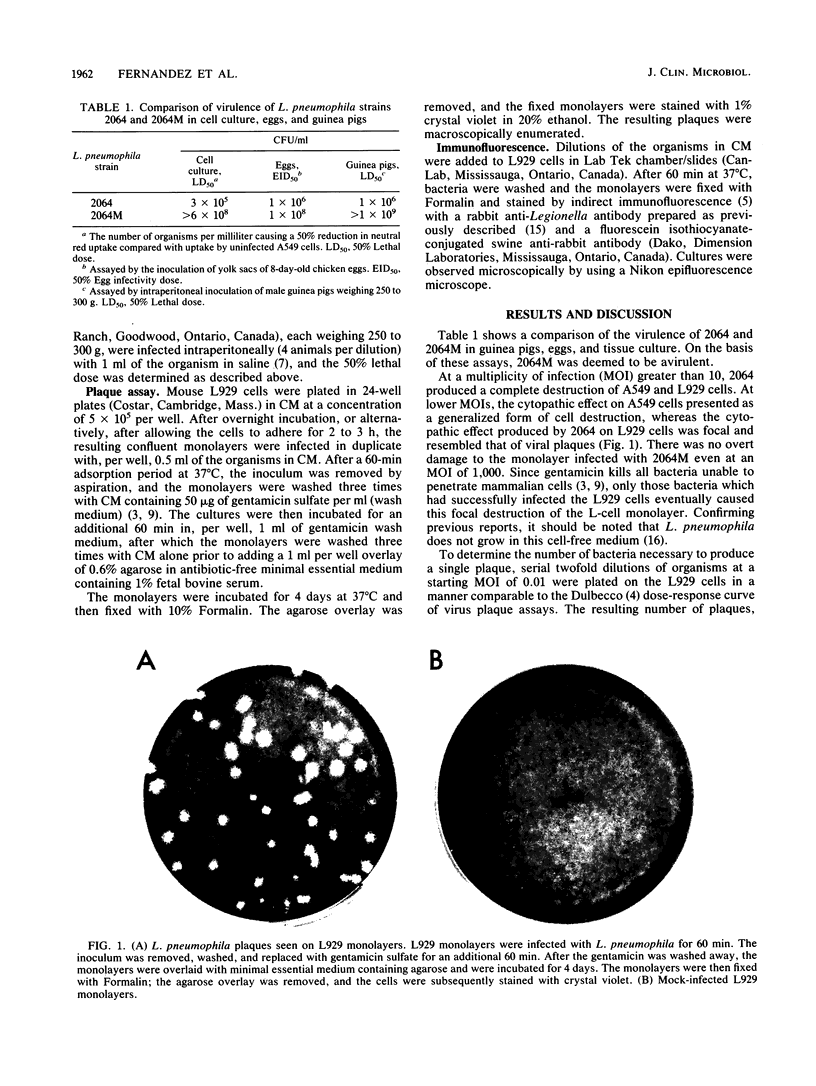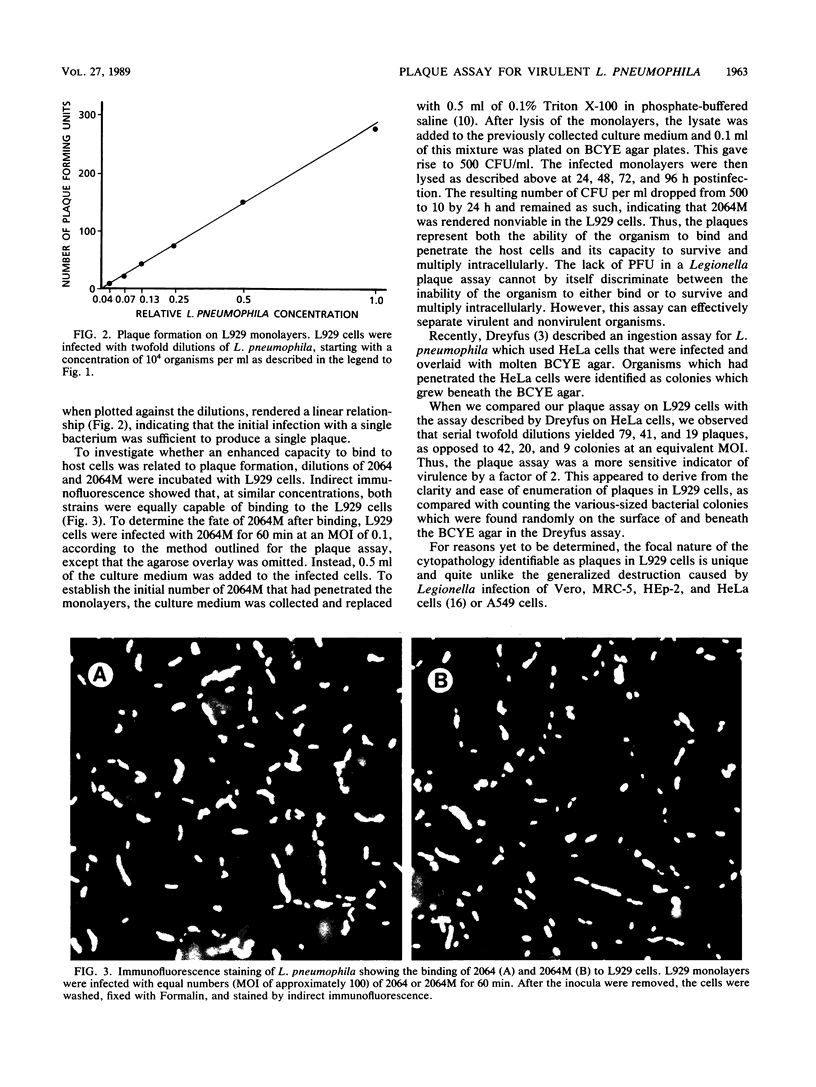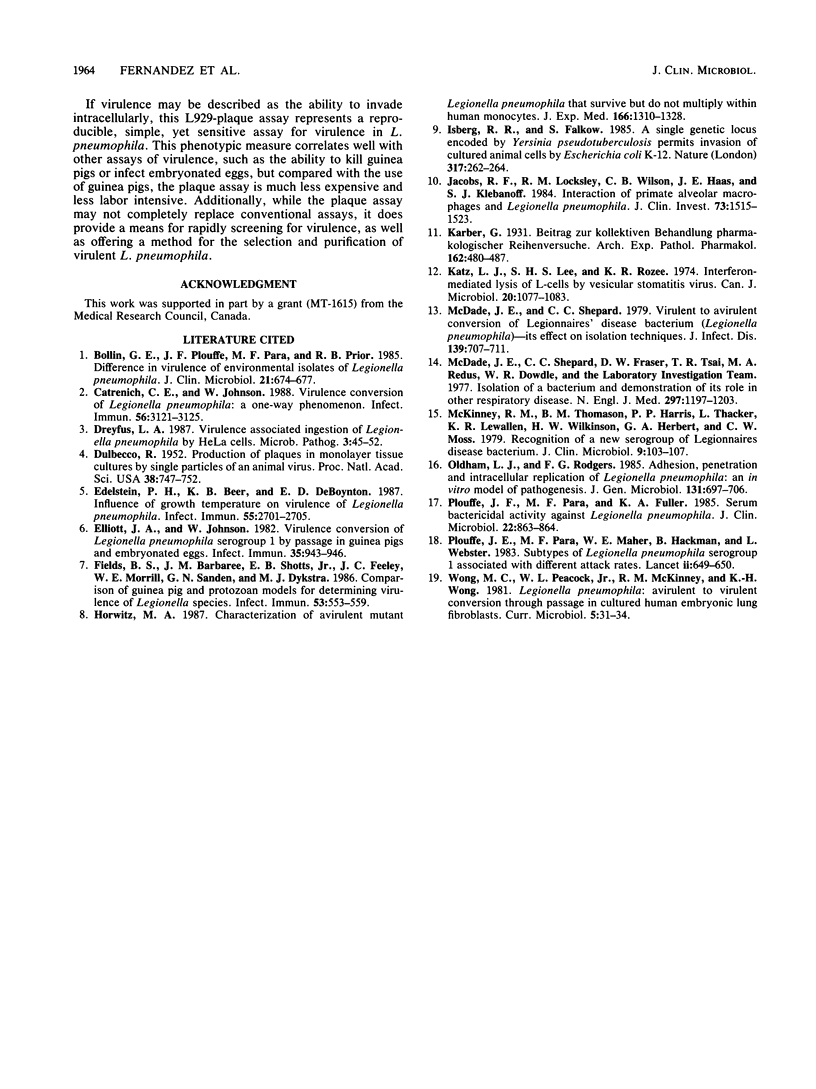Abstract
Methods of assessing virulence of Legionella pneumophila, the etiologic agent of Legionnaires disease, include the infection of guinea pigs, fertile chicken eggs, and mammalian and protozoan cell cultures. Guinea pig assays, in particular, are expensive, laborious, or unsuitable for routine screening of Legionella isolates. We have developed a virulence assay that requires the enumeration of viruslike plaques which are the result of virulent L. pneumophila infecting mouse L929 cells. Each plaque is the consequence of the initial infection of an L cell with a single bacterium. A nonvirulent mutant derived from the serial passage of virulent L. pneumophila on Mueller-Hinton agar fails to survive within L cells and consequently fails to produce plaques.
Full text
PDF



Images in this article
Selected References
These references are in PubMed. This may not be the complete list of references from this article.
- Bollin G. E., Plouffe J. F., Para M. F., Prior R. B. Difference in virulence of environmental isolates of Legionella pneumophila. J Clin Microbiol. 1985 May;21(5):674–677. doi: 10.1128/jcm.21.5.674-677.1985. [DOI] [PMC free article] [PubMed] [Google Scholar]
- Catrenich C. E., Johnson W. Virulence conversion of Legionella pneumophila: a one-way phenomenon. Infect Immun. 1988 Dec;56(12):3121–3125. doi: 10.1128/iai.56.12.3121-3125.1988. [DOI] [PMC free article] [PubMed] [Google Scholar]
- Dreyfus L. A. Virulence associated ingestion of Legionella pneumophila by HeLa cells. Microb Pathog. 1987 Jul;3(1):45–52. doi: 10.1016/0882-4010(87)90036-2. [DOI] [PubMed] [Google Scholar]
- Dulbecco R. Production of Plaques in Monolayer Tissue Cultures by Single Particles of an Animal Virus. Proc Natl Acad Sci U S A. 1952 Aug;38(8):747–752. doi: 10.1073/pnas.38.8.747. [DOI] [PMC free article] [PubMed] [Google Scholar]
- Edelstein P. H., Beer K. B., DeBoynton E. D. Influence of growth temperature on virulence of Legionella pneumophila. Infect Immun. 1987 Nov;55(11):2701–2705. doi: 10.1128/iai.55.11.2701-2705.1987. [DOI] [PMC free article] [PubMed] [Google Scholar]
- Elliott J. A., Johnson W. Virulence conversion of Legionella pneumophila serogroup 1 by passage in guinea pigs and embryonated eggs. Infect Immun. 1982 Mar;35(3):943–946. doi: 10.1128/iai.35.3.943-946.1982. [DOI] [PMC free article] [PubMed] [Google Scholar]
- Fields B. S., Barbaree J. M., Shotts E. B., Jr, Feeley J. C., Morrill W. E., Sanden G. N., Dykstra M. J. Comparison of guinea pig and protozoan models for determining virulence of Legionella species. Infect Immun. 1986 Sep;53(3):553–559. doi: 10.1128/iai.53.3.553-559.1986. [DOI] [PMC free article] [PubMed] [Google Scholar]
- Horwitz M. A. Characterization of avirulent mutant Legionella pneumophila that survive but do not multiply within human monocytes. J Exp Med. 1987 Nov 1;166(5):1310–1328. doi: 10.1084/jem.166.5.1310. [DOI] [PMC free article] [PubMed] [Google Scholar]
- Isberg R. R., Falkow S. A single genetic locus encoded by Yersinia pseudotuberculosis permits invasion of cultured animal cells by Escherichia coli K-12. Nature. 1985 Sep 19;317(6034):262–264. doi: 10.1038/317262a0. [DOI] [PubMed] [Google Scholar]
- Jacobs R. F., Locksley R. M., Wilson C. B., Haas J. E., Klebanoff S. J. Interaction of primate alveolar macrophages and Legionella pneumophila. J Clin Invest. 1984 Jun;73(6):1515–1523. doi: 10.1172/JCI111357. [DOI] [PMC free article] [PubMed] [Google Scholar]
- Katz L. J., Lee S. H., Rozee K. R. Interferon-mediated increased lysis of L-cells by vesicular stomatitis virus. Can J Microbiol. 1974 Aug;20(8):1077–1083. doi: 10.1139/m74-169. [DOI] [PubMed] [Google Scholar]
- McDade J. E., Shepard C. C., Fraser D. W., Tsai T. R., Redus M. A., Dowdle W. R. Legionnaires' disease: isolation of a bacterium and demonstration of its role in other respiratory disease. N Engl J Med. 1977 Dec 1;297(22):1197–1203. doi: 10.1056/NEJM197712012972202. [DOI] [PubMed] [Google Scholar]
- McDade J. E., Shepard C. C. Virulent to avirulent conversion of Legionnaires' disease bacterium (Legionella pneumophila)--its effect on isolation techniques. J Infect Dis. 1979 Jun;139(6):707–711. doi: 10.1093/infdis/139.6.707. [DOI] [PubMed] [Google Scholar]
- McKinney R. M., Thomason B. M., Harris P. P., Thacker L., Lewallen K. R., Wilkinson H. W., Hebert G. A., Moss C. W. Recognition of a new serogroup of Legionnaires disease bacterium. J Clin Microbiol. 1979 Jan;9(1):103–107. doi: 10.1128/jcm.9.1.103-107.1979. [DOI] [PMC free article] [PubMed] [Google Scholar]
- Oldham L. J., Rodgers F. G. Adhesion, penetration and intracellular replication of Legionella pneumophila: an in vitro model of pathogenesis. J Gen Microbiol. 1985 Apr;131(4):697–706. doi: 10.1099/00221287-131-4-697. [DOI] [PubMed] [Google Scholar]
- Plouffe J. F., Para M. F., Fuller K. A. Serum bactericidal activity against Legionella pneumophila. J Clin Microbiol. 1985 Nov;22(5):863–864. doi: 10.1128/jcm.22.5.863-864.1985. [DOI] [PMC free article] [PubMed] [Google Scholar]
- Plouffe J. F., Para M. F., Maher W. E., Hackman B., Webster L. Subtypes of Legionella pneumophila serogroup 1 associated with different attack rates. Lancet. 1983 Sep 17;2(8351):649–650. doi: 10.1016/s0140-6736(83)92531-x. [DOI] [PubMed] [Google Scholar]




